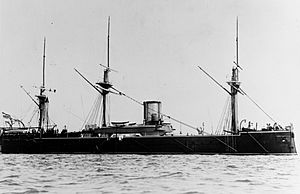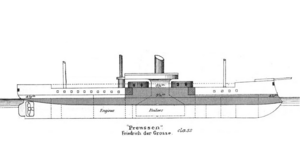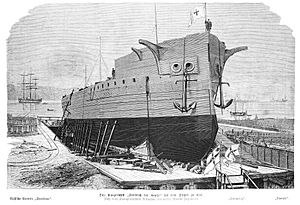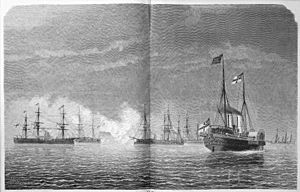SMS Friedrich der Grosse (1874) facts for kids

Friedrich der Grosse in 1887
|
|
Quick facts for kids History |
|
|---|---|
| Name | SMS Friedrich der Grosse |
| Namesake | King Frederick the Great |
| Builder | Kaiserliche Werft, Kiel |
| Laid down | 15 April 1871 |
| Launched | 20 September 1874 |
| Commissioned | 22 November 1877 |
| Stricken | 21 January 1919 |
| Fate | Scrapped, 1920 |
| General characteristics | |
| Class and type | Preussen-class ironclad |
| Displacement | |
| Length | 96.59 m (316 ft 11 in) |
| Beam | 16.30 m (53 ft 6 in) |
| Draft | 7.11 m (23 ft 4 in) |
| Installed power | |
| Propulsion | |
| Sail plan | Full-rigged ship |
| Speed | 14 knots (26 km/h; 16 mph) |
| Range | 1,690 nmi (3,130 km) at 10 kn (19 km/h) |
| Complement |
|
| Armament |
|
| Armor |
|
The SMS Friedrich der Grosse was a powerful warship known as an ironclad turret ship. It was built for the German Imperial Navy (Kaiserliche Marine). This ship was the second of three Preussen-class ironclads, with its sister ships being Preussen and Grosser Kurfürst. The ship was named after Frederick the Great, a famous Prussian king. It was built at the Imperial Dockyard in Kiel, starting in 1871 and finished in 1877. Its main weapons were four large 26 cm (10 in) guns, placed in two gun turrets in the middle of the ship.
Friedrich der Grosse was part of the German fleet from 1877 until 1896. Even though it was often kept in reserve, it regularly took part in the yearly fleet training exercises. It also went on several trips in the Baltic and Mediterranean Seas. Sometimes, it even escorted Kaiser Wilhelm II during his official visits to other countries. In 1896, the ship was taken out of active service. After that, it was used for other jobs until 1919. Finally, it was removed from the naval register, sold, and taken apart for scrap in 1920.
Contents
Building the Ironclad
The three Preussen-class ironclads were planned in 1867. This was part of a plan to make the North German Federal Navy stronger. The navy needed to be improved after the Second Schleswig War, when the Prussian Navy was too weak to stop a blockade by the Danish Navy. These ships were first designed as casemate ships, but their plans were changed to make them turret ships instead. They were the first group of similar ironclads built for the German fleet.
Friedrich der Grosse was 96.59 meters (316.9 ft) long from end to end. It was 16.30 m (53.5 ft) wide and had a draft of 7.12 m (23.4 ft). The ship was powered by one steam engine that turned a single screw propeller. Six coal-fired boilers made the steam, and the smoke went out through one funnel. The ship could reach a top speed of 14 knots (26 km/h; 16 mph). It also had a full set of sails, like a sailing ship. The crew usually included 46 officers and 454 sailors.
Its main weapons were four 26 cm (10.2 in) L/22 guns. These were placed in two gun turrets right in the middle of the ship. When first built, it also had two 17 cm (6.7 in) guns, one at the front and one at the back. Later, between 1888 and 1890, the ship was updated. It received six, and later ten, 8.8 cm (3.5 in) quick-firing guns. It also got two machine guns and five 35 cm (14 in) torpedo tubes below the waterline.
The armor of Friedrich der Grosse was made of wrought iron. Behind the iron was a thick layer of teak wood. The armored belt around the ship had two parts. The upper part was 203 mm (8 in) thick. The lower part was between 102 to 229 mm (4 to 9 in) thick. Both parts had 234 to 260 mm (9.2 to 10.2 in) of teak behind them. The gun turrets were protected by 203 to 254 mm (8 to 10 in) thick armor on their sides, also with 260 mm of teak.
Ship's Journey
Early Years (1871–1881)
The Imperial Navy ordered Friedrich der Grosse on January 9, 1870. However, construction was delayed because of the Franco-Prussian War. The ship's keel was laid down on April 15, 1871. It was launched on September 20, 1874. At the launch ceremony, Kaiser Wilhelm I officially named the ship. It was commissioned for its first tests on November 22, 1877. Even though it started building before its sister ship Preussen, Friedrich der Grosse took longer to finish. This was because it was built at a new Imperial Dockyard, while Preussen was built by an experienced private company.
The ship's first tests were in the Baltic Sea. But in January 1878, it was moved to Wilhelmshaven and put into reserve. There, the final equipment was installed. It then continued its tests, finishing on May 19 in Kiel. In May, Friedrich der Grosse was supposed to join the Ironclad Training Squadron for summer exercises. But on May 22, while sailing in bad weather, it ran aground near Nyborg. The ship was badly damaged and had to be towed free. Because of this damage and ongoing engine problems, it missed the exercises. These exercises were later canceled after its sister ship Grosser Kurfürst accidentally sank in a collision. Friedrich der Grosse was taken out of service for repairs on June 8.
After the loss of Grosser Kurfürst, the Navy canceled the 1878 summer exercises. Most armored warships were put in reserve until the next year. In May 1879, the armored squadron was restarted. Friedrich der Grosse was recommissioned on May 5 to join the group. This squadron also included Preussen and older ironclads. They mostly stayed in the Baltic Sea for training. In June, they visited Norway. In September, the ships returned to Kiel, and the squadron was put away for the winter. The Kaiser visited the ships on September 19, and Friedrich der Grosse was decommissioned six days later.
In the spring of 1880, the squadron was formed again. Friedrich der Grosse was recommissioned on May 3. It did some quick sea trials before joining the squadron on May 24. This year, a new armored ship, Sachsen, joined the squadron. In June, an Italian ship visited them in Kiel. Again, the squadron stayed in the Baltic for the summer, except for a short visit to Wilhelmshaven in August. The training included battle practice and large-scale exercises in the North and Baltic Seas. The ship was decommissioned for the winter and then recommissioned for the 1881 training on May 3. The summer trip that year was similar to the previous one. In July, the ships hosted a visit from the British reserve squadron, which included the first British ironclad, HMS Warrior. Preussen and the rest of the squadron visited Danzig in September. After that, Friedrich der Grosse was moved to Wilhelmshaven and decommissioned on September 30.
Later Service (1882–1919)
The 1882 training year was much like the ones before. The ship was recommissioned on May 2. Friedrich der Grosse was kept in reserve during the yearly summer exercises starting in 1883. This was because newer ships were joining the fleet. From 1883 to 1885, the ship was updated. It received new boilers and a rebuilt poop deck. Two 37 mm (1.5 in) Hotchkiss guns and five torpedo tubes were added above the water.
The ship was reactivated on April 6, 1888, for training. After tests, it joined the squadron in Kiel on May 22. In July, the ships went on a tour of the Baltic for the new Kaiser Wilhelm II. This trip included visits to St. Petersburg, Stockholm, and Copenhagen. They met the Russian Tsar and the Swedish King. Friedrich der Grosse took part in the fleet exercises that year. On September 29, the ship left the Baltic for Wilhelmshaven. It was temporarily decommissioned before being reactivated on October 1. It then served as a guard ship in Wilhelmshaven.
Friedrich der Grosse returned to Kiel on May 4, 1889, to join the Training Squadron. In August 1889, it took part in Kaiser Wilhelm II's visit to Great Britain. The fleet then did exercises in the North Sea before returning to Germany. The squadron was initially broken up for an overhaul. But the work was stopped when Friedrich der Grosse and other ships were called back. They became the training squadron for 1889–1890, the first time the German Navy kept an ironclad force year-round. Friedrich der Grosse and Preussen left Wilhelmshaven on September 26 to join the squadron in Plymouth, Britain. The squadron escorted Kaiser Wilhelm II's yacht to the Mediterranean. This trip included visits to Italy and the Ottoman Empire. They also escorted Wilhelm to Athens, Greece, for his sister's wedding. The squadron stayed in the Mediterranean until April 1890, then returned to Germany.
Friedrich der Grosse went back to the Imperial Shipyard in Wilhelmshaven for the overhaul. The work was finished by May 8, and the ship immediately left for Kiel to join the Training Squadron. The unit did exercises in June before escorting Wilhelm II on a visit to Norway. It was present for the transfer of Helgoland island from British to German control in July. It also took part in the fleet exercises in September. Here, the entire eight-ship armored squadron pretended to be a Russian fleet blocking Kiel. The exercises also included working with army units along the coast. The exercises ended on September 11. Four days later, the ship returned to Wilhelmshaven. It was decommissioned on September 22 for a more thorough overhaul.
Friedrich der Grosse was out of service until October 10, 1891. Then, it was recommissioned and joined the Training Squadron again. It took part in training operations in the winter of 1891–1892. These began with exercises in the North Sea before moving to the Baltic in January 1892. It was part of a naval review in Kiel for the visit of the Russian Tsar on June 7. The 1892 exercises lasted from August 23 to September 28. These included exercises in both the North and Baltic Seas. After this, Friedrich der Grosse returned to Wilhelmshaven to be a guard ship again.
After returning to active service in 1893, Friedrich der Grosse went on a solo trip in the Baltic. It then joined the rest of the fleet later that year. It took part in the 1893 exercises, which included pretending to defend against a French naval attack in the North Sea. In mid-October, it joined a division, but had to return to Wilhelmshaven on December 2 for maintenance. The next year, Friedrich der Grosse, König Wilhelm, and Deutschland joined the new battleship Brandenburg. In April 1894, this division did a training cruise to get ready for the summer exercises. While sailing, König Wilhelm ran aground, and Friedrich der Grosse helped pull it free. The ships then sailed to Scotland. They returned to Kiel in May to get more coal and supplies. The 1894 exercises involved pretending to defend against a Russian attack on Germany's Baltic coast.
The navy thought about rebuilding the ship into an armored cruiser. This would have been similar to other ships and could have sent it to East Asia. However, these plans did not happen. Instead, Friedrich der Grosse was decommissioned on October 12, 1894. It was then put into inactive reserve. On November 16, 1896, it was changed from a warship to a special purpose ship. After that, it became a harbor ship. It was removed from the list of active ships on May 21, 1906. From late 1906, it was used as a coal hulk for torpedo boats. Friedrich der Grosse served in this way until after World War I. It was officially removed from the naval register on January 27, 1919. It was sold to companies that break up ships and was taken apart for scrap in 1920 in Rönnebeck.
Images for kids








